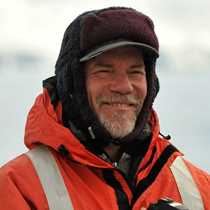Sitting on the foredeck of the National Geographic Endeavour in the early evening, just a few miles north of the Tropic of Cancer, the long, low Atlantic swells are rolling through, uninterrupted, from one horizon to the other. Looking out over these great plains of salt water, it is very difficult to conceive of the vast and terrible landscapes beneath our ship. Great mountains sweep up from the abyss all around us; we have come to know a few of them, but only on their summits, which seem to be mere scraps of land, floating among the waves. Their long slopes are lost to us, locked in darkness far below.
Recently, our ROV gave us a small glimpse of what unexpected vistas the sea conceals. We sent our little robot down below the ragged cliffs of the Desertas Islands, part of the Madeira group. Descending to 385 feet, we found, not more rocky battlements, but a wide flat bench of soft sand. Not so long ago, this drowned landscape was part of the upper world of air and light; 20 or 30 thousand years ago, when woolly mammoths roamed the steppes of Europe and our ancestors were painting their images in caves, sea level stood lower and the Atlantic waves crashed over these sands.
Today this long-submerged beach is home to a thin forest of wire coral, a few sponges and a lonely gurnard that stared at the lights of our ROV in consternation, then fled as we approached. Scatted here and there were round pits a meter or so across, evidence that larger animals, like the beautiful Wide-winged Butterfly Ray, had been there feeding on crabs or clams living in the sand.
Our short journey over this Ice Age beach was just enough to whet our appetites and fire our imaginations. Now, a day south of the Canaries with the sea spread all around us, we can’t help but wonder what landscapes are hidden here, far below the clouds and waves that surround our ship.




